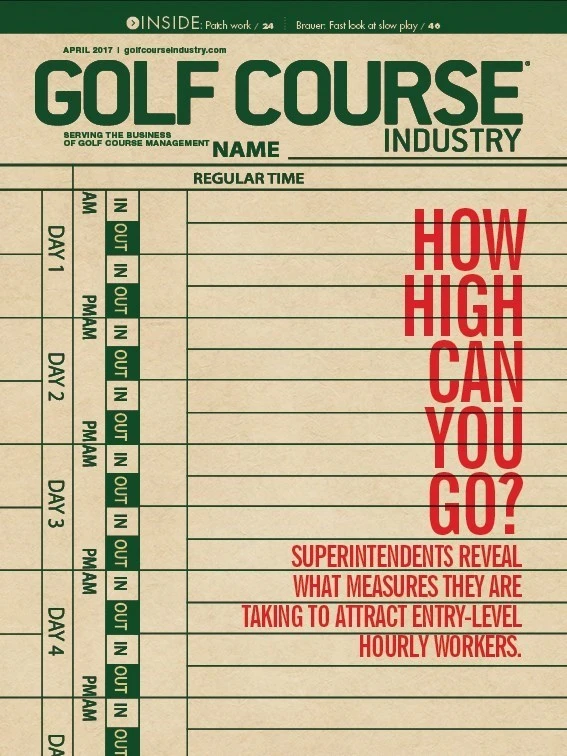Pace of play is a major issue in golf. Back in 2009, I covered speed of play in this column. My ideas from 2009 still hold true, and as Casey Stengel said, you could look them up!
Eight years later, some things haven’t changed, like the statistically improbable occurrence of the slowest players always being in front of me. What has changed, in the case of pace, is additional research, and more consultants professing ability to convert your turtle races to a greyhound track. And, more, if less researched opinions, still surface, such as:
- Picturesque holes that are “selfie centered” (I’m looking at you, Pat Jones!)
- Eliminate variety in green contours to make greens easier to read.
- Eliminate variety in hole difficulty, as mixing hard and easy slows play.
Few golf course architects consider these desirable, believing a variety of unique courses draws and holds players to the game. Most golfers play where they can shoot about their average score.
Despite slow play concerns, I doubt we will return to an era of dull, hazardless “golf factories” to accommodate poor players and beginners. They have played all kinds of courses, and know the difference. They also know that they prefer better courses, to a point. Plain courses close, while “fancier” courses, survive, albeit, sometimes at lower price points. And there is little to suggest this trend will change.
However, looking at the bigger picture, there are problems design tweaks can’t address. Eliminating certain design features here and there can speed play, but retrofitting existing courses is a big task, as nearly every design trend since World War II ignored pace of play as a design criteria:
- In the ’50s and ’60s, Trent Jones and Dick Wilson led the way in designing nearly every course as a championship test and tour tough courses are too difficult for average golfers, slowing play. Multiple tees were a poorly thought out concession.
- In the ’60s and ’70s, most courses were built within real estate developments to defray construction cost. While closer to home and quicker to get to, more O.B. and longer cart rides between holes to maximize golf course lots added time to every round.
- In the ’80s and ’90’s the “Country Club for a Day” movement took over, and more public courses were designed to be as difficult as private courses. Even muni courses were no longer bunny and green slopes for golf.
- From 1990 on, environmental concerns became dominant design considerations, causing more forced carries and long cart rides and reduced turf. Cost pressures turned many acres of fairways into cheaper rough, and rough into no mow areas, causing more lost golf balls, more searches and more time added to the round.
It’s hard to measure the aggregate effect of these trends, but they are major drivers of slow play. If pace of play becomes a higher design priority, design will certainly change, too. I predict a more specialized market, with more tailored designs, rather than focusing on the one size fits all “championship course.” The bell curve probably applies:
- For the bottom 10 to 20 percent of courses, pace of play concerns should be top priority.
- For the top 10 to 20 percent of courses, pace of play concerns should be a lower priority than creating a unique and challenging course.
- For the 60 to 80 percent of courses in the middle of the pack, design priority of pace of play should be elevated to first, or at least 1A status with strategy, aesthetics, ease of maintenance and environmental sensitivity.
Even then, it won’t be easy to turn the design tide.
Some will believe those changes come at the cost of “lower” quality as measured by current standards. The question is, “quality for who?” We might be forced into new design paradigms, starting with stopping design primarily for top players. Most courses would benefit from focusing on enjoyment of the average game of bogey golfers. Some new paradigms will paradoxically borrow from some very old ones.
Not all solutions will be design solutions. Relaxed USGA rules and course policies are a major component in this battle. At most courses, a combination of little thing will add up to slightly shorter rounds. However, we must address overcoming at least 60 years of design that causes our current slow play problem.
Get curated news on YOUR industry.
Enter your email to receive our newsletters.
Explore the April 2017 Issue
Check out more from this issue and find your next story to read.
Latest from Golf Course Industry
- Carolinas GCSA raises nearly $300,000 for research
- Advanced Turf Solutions’ Scott Lund expands role
- South Carolina’s Tidewater Golf Club completes renovation project
- SePRO to host webinar on plant growth regulators
- Turfco introduces riding applicator
- From the publisher’s pen: The golf guilt trip
- Bob Farren lands Carolinas GCSA highest honor
- Architect Brian Curley breaks ground on new First Tee venue






